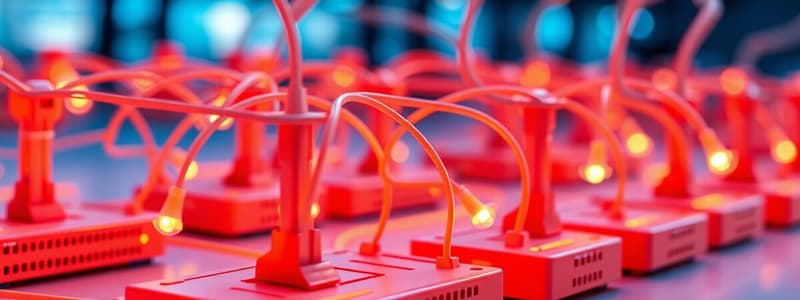Podcast
Questions and Answers
What is the primary function of intermediary devices in a network?
What is the primary function of intermediary devices in a network?
- To connect multiple networks or segments (correct)
- To access the internet on behalf of clients
- To manage end systems directly
- To store data temporarily for users
Which connection type typically serves home and small office environments?
Which connection type typically serves home and small office environments?
- Fiber optic networks
- Dedicated internet lines
- Leased lines
- Broadband connections (correct)
What distinguishes a Peer-To-Peer model from a Client/Server model?
What distinguishes a Peer-To-Peer model from a Client/Server model?
- Peer-To-Peer uses dedicated servers for data
- Client/Server prevents direct communication between devices
- Peer-To-Peer shares resources directly between clients (correct)
- Client/Server allows file sharing among all devices
Which statement about LANs and WANs is accurate?
Which statement about LANs and WANs is accurate?
What is the main role of edge networks in the context of internet connectivity?
What is the main role of edge networks in the context of internet connectivity?
Which aspect of network media is typically considered when discussing physical media?
Which aspect of network media is typically considered when discussing physical media?
In which model do devices act both as suppliers and consumers of resources?
In which model do devices act both as suppliers and consumers of resources?
What is a primary feature of the Client/Server model?
What is a primary feature of the Client/Server model?
What characterizes a Wide Area Network (WAN)?
What characterizes a Wide Area Network (WAN)?
Which statement is true regarding Local Area Networks (LANs)?
Which statement is true regarding Local Area Networks (LANs)?
Which of the following is NOT a characteristic of LANs?
Which of the following is NOT a characteristic of LANs?
What is a key difference between LANs and WANs?
What is a key difference between LANs and WANs?
What type of network connects millions of devices across the globe?
What type of network connects millions of devices across the globe?
In which scenario would a Small Office/Home Office network be most appropriate?
In which scenario would a Small Office/Home Office network be most appropriate?
Which describes the primary function of telecommunication network technologies?
Which describes the primary function of telecommunication network technologies?
What is a characteristic of network infrastructures?
What is a characteristic of network infrastructures?
What is the primary role of end devices in a network?
What is the primary role of end devices in a network?
Which of the following describes the Internet’s main protocols?
Which of the following describes the Internet’s main protocols?
In the context of network components, what are intermediary devices primarily used for?
In the context of network components, what are intermediary devices primarily used for?
How can end devices be categorized based on their function in communication?
How can end devices be categorized based on their function in communication?
What distinguishes the Client/Server model from the Peer-to-Peer model?
What distinguishes the Client/Server model from the Peer-to-Peer model?
What is an example of a physical medium used to connect hosts to the network?
What is an example of a physical medium used to connect hosts to the network?
What happens when an end device initiates communication?
What happens when an end device initiates communication?
What does the term 'hosts' refer to in the context of network communication?
What does the term 'hosts' refer to in the context of network communication?
What is one of the primary functions of a networking device?
What is one of the primary functions of a networking device?
Which of the following is NOT a common way for home users to connect to the internet?
Which of the following is NOT a common way for home users to connect to the internet?
What is the term used to describe the format and order of messages exchanged in a network?
What is the term used to describe the format and order of messages exchanged in a network?
Which statement best describes the role of security settings in a network?
Which statement best describes the role of security settings in a network?
In communication protocols, what typically happens after a connection request is sent to a web server?
In communication protocols, what typically happens after a connection request is sent to a web server?
Which of the following connection types is often used by businesses rather than individual home users?
Which of the following connection types is often used by businesses rather than individual home users?
What action is typically taken when using human communication protocols?
What action is typically taken when using human communication protocols?
What is a common trait of all connection methods for home users mentioned?
What is a common trait of all connection methods for home users mentioned?
What is the main purpose of decoding in communication protocols?
What is the main purpose of decoding in communication protocols?
What governs the restrictions on message size in transmission?
What governs the restrictions on message size in transmission?
Which of the following best describes flow control?
Which of the following best describes flow control?
What does the access method in communication protocols determine?
What does the access method in communication protocols determine?
What happens when a message frame is too long or too short?
What happens when a message frame is too long or too short?
When is response timeout relevant in communication protocols?
When is response timeout relevant in communication protocols?
What is a key function of the Internet Protocol Version 6 (IPv6)?
What is a key function of the Internet Protocol Version 6 (IPv6)?
What are proactive collision management protocols designed to do?
What are proactive collision management protocols designed to do?
Flashcards are hidden until you start studying
Study Notes
Introduction to Networking
- Networking involves connecting computers and devices to share resources and information.
- Networks vary in size: from small home networks to global networks like the Internet.
Computer Networks
- Computer networks interconnect devices for communication and resource sharing.
- Key types include Local Area Networks (LANs) and Wide Area Networks (WANs).
LANs and WANs
- LAN: Limited geographical area (e.g., home, office), administered by an individual or organization.
- WAN: Covers wide areas; managed by larger corporations or telecommunications providers.
- Factors distinguishing networks: geographic coverage, user count, service types, and administrative reach.
What is the Internet?
- The Internet is a vast network connecting millions of devices globally.
- Governed by TCP/IP protocols that format and manage data exchange.
Edge Network
- Comprises components like end systems (hosts), access networks (routers, switches), and physical media (cables, wireless).
- End Systems: Devices like computers and smartphones that send/receive messages.
- Access Networks: Technologies enabling Internet connectivity.
- Physical Media: Includes copper cables, fiber optics, and wireless connections.
End Systems and Models
- End devices can act as clients, servers, or both in a network.
- Client/Server Model: Clients request services from servers.
- Peer-to-Peer Model: Devices interact directly without centralized servers.
Network Connection Methods
- Common home connection methods:
- Cable
- DSL
- Dial-up
- Satellite
- Business methods include dedicated leased lines and Metro Ethernet.
Communication Protocols
- A protocol defines message formats and transmission order between communication entities.
- Message Formatting: Requires specific structures; varies by message type.
- Message Size: Long messages must be segmented into smaller frames.
- Message Timing: Includes flow control, response timeouts, and access methods to manage data transmission and potential collisions.
Key Terms
- Network Core: Backbone of the network; includes intermediary devices facilitating communication.
- Intermediary Devices: Devices that help manage data flow, like routers and switches.
This summary offers a concise overview of the essential components and concepts of networking as described.
Studying That Suits You
Use AI to generate personalized quizzes and flashcards to suit your learning preferences.




